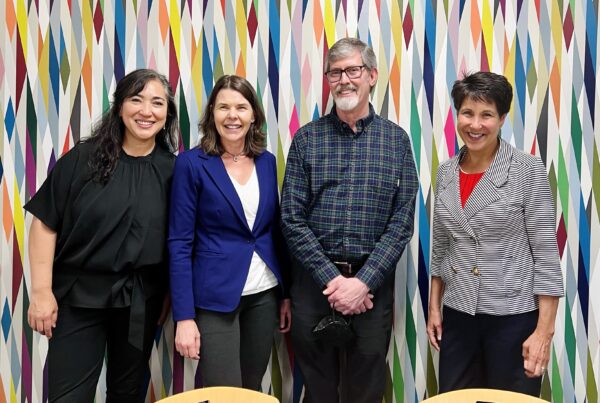
The regional director of the U.S. Department of Health and Human Services recently visited Alaska to tour health care facilities and meet with state, local and tribal health officials.
It was Ingrid Ulrey’s first visit to the state as the department’s Region 10 director, and she said she heard a lot about Alaska’s unique, health-related challenges, which she hopes the federal health department — and funding through some of its grant programs — can help with.
Ulrey says those challenges include a mental health crisis, disparities in health outcomes during the COVID-19 pandemic and a severe health care worker shortage.
Listen:
[Sign up for Alaska Public Media’s daily newsletter to get our top stories delivered to your inbox.]
The following transcript has been lightly edited for clarity.
Ingrid Ulrey: The caring professions, in health care and childcare, and particularly within behavioral health, are really challenged now to recruit and attract the workforce we need to take care of the population. It’s about getting people in through a pipeline, and it’s about keeping them and ensuring they don’t get burned out. The over reliance on traveling nurses is fiscally not sustainable. So how do we get more nurses into the system? I did talk with Alaska Native Tribal Health Consortium and their partnership with Alaska Pacific University, to ease those pipelines and make it as easy as possible to have that partnership between academia and a hospital setting and get more nurses trained. And it’s not just nurses, you know, it’s the people at the front desk, it’s the techs, the medical assistants — huge shortage there — and looking at how do you encourage people to come and work in health care, and if you’re at the lower-level positions, provide wraparound support, to get the education, certification, training, you need to to move up a career ladder? So there’s a lot of innovation happening in Alaska. But it is a big challenge going forward, and one that HHS is putting a lot of energy and focus in, particularly through the HRSA, or Health Resources Services Administration, through which a lot of funds flow here to Alaska to support community health.
Casey Grove: With some of the groups that you’ve been talking with, how would they characterize what we’re calling a mental health crisis? And I guess, how would you characterize that as well?
IU: There are a lot of elements to this. I would say one thing, bottom line, we need to keep people alive. Everyone here knows that Alaska has historically had one of the highest suicide rates in the nation. Losing people to suicide is devastating — for families, for community. I’ve been talking with a lot of folks here about that. And Alaska is moving towards a “crisis now” model, where we’re beefing up our ability to ensure that people have a place to call. So the Suicide Hotline, a very simple three digit, 988, number to call for people who are in a suicide or other mental health crisis. Some portion of those need not only a place to call, but a mobile team to come out and attend to them. Not necessarily just law enforcement, but people trained in behavioral health. That is starting to be developed around the state of Alaska, as well as a place to go for stabilization in a crisis. And then, long haul, some people need a longer-term residential bed. And that’s, I know, and I’m well aware and have spoken with people about the limitation of beds and the challenge of having people boarding in the emergency department of hospitals who really need — they don’t need hospital level of care, they need mental health support. So I think there’s a lot of innovation and positive work happening in Alaska and moving towards a model where we can support people and save lives that are now being lost to suicide.
CG: Your region encompasses a few states, including Alaska, of course, but also 270-plus tribes, right? So you must work very closely with the tribal health organizations, I imagine.
IU: Absolutely. So our government-to-government relationships with the tribes is a major and important part of my work as Region 10 director. So as you said, this region covers Oregon, Washington, Idaho and Alaska, and in addition 272 federally recognized tribes. I really deeply appreciate the leadership in tribal health here in Alaska. We work closely with the Alaska Native Health Board, ANTHC and Alaska Native Medical Center, Southcentral Foundation. I had a chance just this week to visit ANTHC and their leader, Val Davidson, really, who’s doing such innovative work, as well as to get out of Anchorage and visit the Seldovia Village Tribe Health and Wellness Center and see what health care looks like in rural Alaska. I really look forward to coming back and spending more time getting out to rural areas of the state to see how this unique tribal health system is working and how HHS, as the government partner to the tribes, can work with them to strengthen access to care.
CG: Are there things about that that are unique that you notice, compared to maybe other places that you visit, that just looks different or works differently here?
IU: I think that’s a common theme. Everything about Alaska is unique and different than how things work in the Lower 48. So I think understanding the complexity of the tribal health system, the regional corporations, certain issues like, for example, telehealth. There’s nowhere in the country where that’s more important than Alaska. And it’s unusual to have a Medicaid program that pays for travel, which is essential, because beyond basic primary care off the road system, we understand, that help, people need to travel for specialty care or hospital care. So the travel is expensive, though, and I understand the Medicaid program, the funding for it, is often not sufficient. Sort of bridge those coverage gaps, to build up the broadband network necessary in the state to support telehealth and not only virtual visits, but just audio only at this time is really important. So I couldn’t underscore how vivid it is to see the value of telehealth, and what we’ve learned that we can provide health care virtually in an effective way, especially for behavioral health. That is very unique to Alaska, how important that’s going to be.
CG: I think, just in the last week or so, we saw a report that looked at data from the COVID-19 pandemic, and it showed that Alaska Native folks were were more susceptible, on average, to COVID-19. And what are people telling you about that? And what has the discussion about that been like?
IU: So throughout this whole pandemic, one of the biggest struggles has been disparate impacts on specific communities, including communities of color, people who are immunocompromised, and older adults who are who are much more at risk of serious illness and death, and including the American Indian-Alaskan Native population, who historically have higher rates of some of those underlying conditions like diabetes that make you more susceptible to becoming seriously ill. And for COVID to be a real threat, you know, not just something where you get a positive test but no symptoms or just you feel like you have a cold for a few days. For people who have co-occurring conditions like diabetes, or obesity, and health history, COVID can be a serious threat. There’s also the growing concern about long COVID and what that means. And there’s a lot, the science is evolving. There’s so many different symptoms that people are reporting, but it could mean an increase in our disability population. And there could be disparate impacts, including in American Indian-Alaskan Native populations. So in working with ANTHC, as well as all the tribal health organizations- the tribes were actually so innovative and did such good work on getting people vaccinated, getting people tested. Now, it’s really the long haul of how do we ensure ongoing vigilance, and like I said earlier, attend to those mental health and behavioral health increased challenge that happened coming out of COVID.
Casey Grove is host of Alaska News Nightly, a general assignment reporter and an editor at Alaska Public Media. Reach him atcgrove@alaskapublic.org. Read more about Caseyhere.





